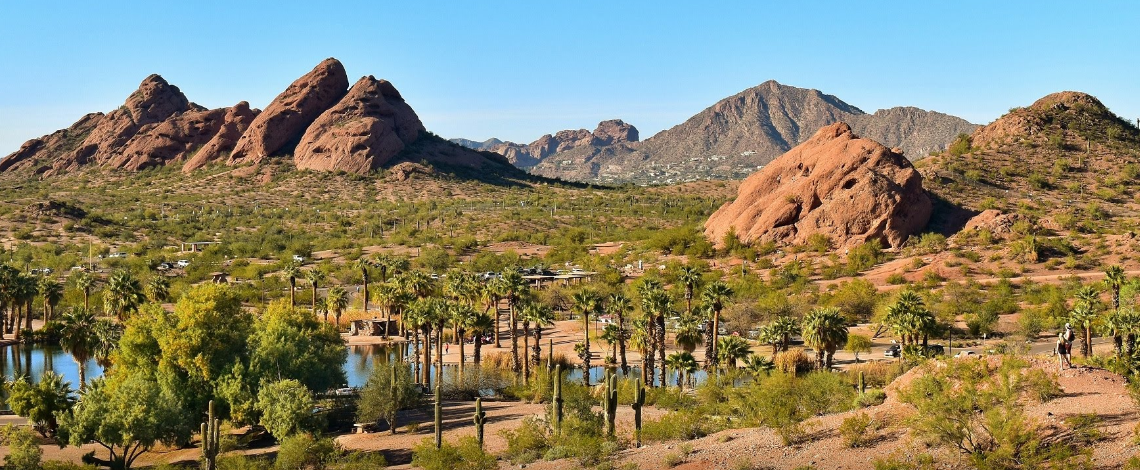
Papago Park
July 18, 2018The oddly shaped Buttes of Papago Park are easily recognized natural landmarks within central Arizona. The park preserves its small piece of the Sonoran Desert within the urban metropolis that is Phoenix, Arizona and its suburbs. The land is shared between two cities with most of Papago Park located in southeastern Phoenix, and the remaining 20% spilling into northern Tempe. The landscape is filled with a collection of distinctive red sandstone buttes that formed between 15 to 6 million years ago. The surface of the buttes are marked by a number of crevices and holes that formed from weathering and erosion over this long span of time.
The most well known formation in the buttes is named The Hole-in-the-Rock, a large opening that pierces on of the buttes, allowing views from one side to the other. For several hundred years, Hole-in-the-Rock was used by the ancient Hohokam Native Americans as a calendar to place. They understood that the hole caused a ray of light to be cast that would change positions on the floor throughout the year. Keeping track of the movement of the sun allowed them to accurately time the seasons and plant and harvest the crops accordingly. The Hohokam inhabited the area until about the year 1415. Their modern descendants are the Pima, that today have a reservation located just east of Scottsdale. The window that the Hole-in-the-Rock formation creates frames the city of Phoenix when looking through it to the southwest. It has attracted residents from the surrounding communities for hiking, picnics and photographs, since the late 1800s, when the modern city of Phoenix was first settled. Today, you can follow a popular trail from the base of the butte and hike up to the hole to gaze out on the city and take some photos.
Papago Park is one the oldest public parks in Phoenix, and efforts to preserve the unique landscape began very early in the city’s history. In 1879, President Rutherford B. Hayes included the Papago Buttes area and a new reservation for the Salt River Pima and Maricopan Native Americans. Only a year later after local opposition, President Hayes moved the western boundary of the reservation two miles to the east, so that the area could remain in the public domain. Several claims were subsequently made by settlers for the land in the last two decades of the 1800s, but these were all eventually rejected.
In 1909, a piece of the land in the Papago Buttes area was withdrawn from the public for the creation of a rifle range for the Arizona National Guard. This northwest portion of the park continued to be used for military purposes over the following century and is still a National Guard base today. In 1914, President Woodrow Wilson created the Papago Saguaro National Monument to preserve what is now the land of Papago Park. The monument included that buttes and large stands of large squirrel cacti in the area. The park continued to see use for recreational purposes and over 8,000 people visited the park in 1922. The park was and continues to be used as a photographic backdrop, and for weddings and other special events.
In 1930, the area’s status as a national monument was recalled by Congress as it was deemed unsuitable for that title. The land was divided between the city of Tempe and the state, but the area largely remained preserved for public recreation. In 1931, Papago Park became home to one of its most unusual attractions. A white pyramid that can easily been see from almost anywhere in the park. The pyramid was built by Arizona’s first and longest serving governor, George W. P. Hunt, as a tomb for he and his wife. Governor Hunt himself was buried there after his death in 1934. His daughter and his wife’s family are also buried there. Governor Hunt played a huge role in the development of Arizona, during its early statehood years and also served as Minister to Siam, moderne Thailand, between 1920 and 1921.
During his world travels, Hunt visited the pyramids in Egypt, becoming fascinated with the ancient civilization and prompting his desire to be buried in the white pyramid, that can still be found in Papago Park today. Governor Hunt chose the site of his family tomb as a place he could watch over the development of Phoenix, which was a much smaller city of about 50,000 people at the time of his death. Today, the Phoenix metropolitan area numbers over 4.5 million people. Visitors to Papago Park today can walk up to the pyramid to pay their respects to Governor Hunt, and also take in an excellent panoramic view of the surrounding buttes and the city of Phoenix and beyond.
This photo was taken near the Governor’s tomb with Camelback Mountain, some of the Papago Buttes and one of the park’s artificial lakes seen amidst the desert plants and palm trees. In the early 1930s, artificial lakes were created in Papago Park and a bass fish hatchery was established. Today, the fish hatchery is gone, but fishing remains a popular recreational activity for visitors. A wide variety of wetland birds including egrets, herons, and ducks can be seen at the lakes. The Civilian Conservation Corps developed a number of trails for the park in the 1930s and built the Adobe Arsenal Building at the military base that houses the Arizona Military Museum today.
In 1939, the Desert Botanical Garden opened in Papago Park, and today is home to over 21,000 plants, many of which are rare or endangered desert species. The garden has a rich collection of agave and cacti, and is one of the most popular attractions amongst visitors to the Phoenix area. During World War II, an infantry regiment was trained at the military base at Papago Park, and a prisoner of war camp was maintained there between 1942 and 1946. About 3,100 prisoners were housed at the camp while it was active. On December 23, 1944, 25 German Navy officers and sailors escaped through a 170 foot tunnel they dug. The Great Papago Escape was the largest escape of prisoners from a POW camp on American soil during World War II. Several hundred soldiers, FBI agents, and Native American scouts were mobilized at the time to locate the escaped Germans, all of whom were eventually captured. More information on this interesting part of the park’s history can be found at the Arizona Military Museum located on the National Guard base today.
The state owned portion of the Papago Buttes land was sold to the city of Phoenix in 1959. In 1962, the Phoenix Zoo opened in Papago Park and is today the largest privately owned, nonprofit zoo in the United States. An 18 hole golf course was built within the Phoenix section of the park in 1963, and remains in use today. The Arizona Historical Society Museum opened in the Tempe portion of Papago Park in 1992. It is one of the largest history museums in the state. Former Supreme Court Justice, Sandra Day O’Connor’s house was moved from nearby Paradise Valley to Papago Park to be preserved as part of the museum, as well. In recent years, the park’s public facilities and features have undergone additions and improvements, including a unique playground for children with a desert wildlife theme.
Papago Park remains an important part of Phoenix and Tempe today, with numerous trails to hike or mountain bike, and the Phoenix Zoo, Desert Botanical Gardens, and multiple museums to explore.
If you enjoyed this video, be sure to hit the like button and subscribe to my channel for future videos. You can also follow me on Instagram to view my photography or visit my blog to learn more about our world. You can watch another video on the Arizona Military Museum right here. Thanks for watching.

